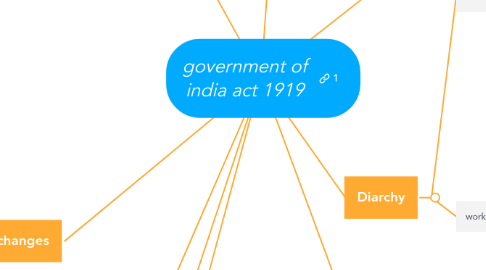
1. Background
1.1. 1st world war
1.2. dissatisfacction among muslim - treatment to caliph
1.3. miseries of peoople due to war
1.4. homerule by tilak and ane besant
2. changes
2.1. central level
2.1.1. bicameral legislature
2.1.1.1. concil of state (60 members, 34 elected)
2.1.1.2. legislative assembly(144 members, 104 elected, rest nominated and officials)
2.2. executive level
2.2.1. indians associated in viceroys council 3/6 were indians
2.2.2. no responsible govt. at centre
2.3. provincial level
2.3.1. diarchy introduced
2.3.2. subjects were divided
2.3.2.1. reserved list
2.3.2.1.1. power to legislate lies in governor
2.3.2.1.2. important subjecs were reserved
2.3.2.2. transferred list
2.3.2.2.1. power to make laws lies in governor on aid of ministers choosen from elected
2.4. analyzing the nature of change
2.4.1. governor and viceroys have overwritting power
2.4.2. no principle of collective responsibility
3. was anything good
3.1. gave oppurtunities to indians
3.2. indian public opinioms expressed
3.3. myth broken, Indians are not worthy to rule
4. opinions about diarchy
4.1. ane besant
4.1.1. Diarchy was unworthy to be offered by british and to be accepted by indians
5. some other changes (pre)
5.1. extension of separate electorate to other religious groups, reservation for backward and nomination for depressed in madras
5.2. create high commissioner and transfer function from secretary to him
5.3. establishment of central public service commision
6. Diarchy
6.1. introduction of bicameral legislature
6.2. working of diarchy
6.2.1. bound to fail
6.2.2. functions of govt. is interdependence
6.2.3. division of subject is illogical
6.2.3.1. agriculture was transferred but irrigation is reserved
6.2.4. no efforts to develop trust in two half's
6.2.5. both the halfs working as cross purpose
6.2.6. ministers working for countrymen and beaurocrates for colonial masters
6.2.7. ministers faced problem
6.2.7.1. lack of control opver finances
6.2.7.2. lack of co-operations from bearocrates
6.2.7.3. answerability to wo masters
6.2.7.3.1. governor
6.2.7.3.2. legislature
7. Aim
7.1. associate indians in every branch of administration
7.2. develpoment of self governing institution
7.3. progressive realisation
8. principle
8.1. complete popular control in local bodies
8.2. provinces will domain
9. Alexander Muddieman committee
9.1. to examine the working of diarchy
9.1.1. no meaningful reform
9.1.2. no real division of authority, on the transfered subject there were de facto control pf governor
9.1.3. lack of co opearaions
